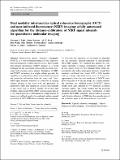Dual modality intravascular optical coherence tomography (OCT) and near-infrared fluorescence (NIRF) imaging: a fully automated algorithm for the distance-calibration of NIRF signal intensity for quantitative molecular imaging
Author(s)
Ughi, Giovanni J.; Verjans, Johan; Fard, Ali M.; Wang, Hao; Osborn, Eric; Hara, Tetsuya; Mauskapf, Adam; Jaffer, Farouc A.; Tearney, Guillermo J.; ... Show more Show less
Download10554_2014_Article_556.pdf (1.747Mb)
PUBLISHER_POLICY
Publisher Policy
Article is made available in accordance with the publisher's policy and may be subject to US copyright law. Please refer to the publisher's site for terms of use.
Terms of use
Metadata
Show full item recordAbstract
Intravascular optical coherence tomography (IVOCT) is a well-established method for the high-resolution investigation of atherosclerosis in vivo. Intravascular near-infrared fluorescence (NIRF) imaging is a novel technique for the assessment of molecular processes associated with coronary artery disease. Integration of NIRF and IVOCT technology in a single catheter provides the capability to simultaneously obtain co-localized anatomical and molecular information from the artery wall. Since NIRF signal intensity attenuates as a function of imaging catheter distance to the vessel wall, the generation of quantitative NIRF data requires an accurate measurement of the vessel wall in IVOCT images. Given that dual modality, intravascular OCT–NIRF systems acquire data at a very high frame-rate (>100 frames/s), a high number of images per pullback need to be analyzed, making manual processing of OCT–NIRF data extremely time consuming. To overcome this limitation, we developed an algorithm for the automatic distance-correction of dual-modality OCT–NIRF images. We validated this method by comparing automatic to manual segmentation results in 180 in vivo images from six New Zealand White rabbit atherosclerotic after indocyanine-green injection. A high Dice similarity coefficient was found (0.97 ± 0.03) together with an average individual A-line error of 22 µm (i.e., approximately twice the axial resolution of IVOCT) and a processing time of 44 ms per image. In a similar manner, the algorithm was validated using 120 IVOCT clinical images from eight different in vivo pullbacks in human coronary arteries. The results suggest that the proposed algorithm enables fully automatic visualization of dual modality OCT–NIRF pullbacks, and provides an accurate and efficient calibration of NIRF data for quantification of the molecular agent in the atherosclerotic vessel wall.
Date issued
2014-10Department
Harvard University--MIT Division of Health Sciences and TechnologyJournal
The International Journal of Cardiovascular Imaging
Publisher
Springer Netherlands
Citation
Ughi, Giovanni J., Johan Verjans, Ali M. Fard, Hao Wang, Eric Osborn, Tetsuya Hara, Adam Mauskapf, Farouc A. Jaffer, and Guillermo J. Tearney. “Dual Modality Intravascular Optical Coherence Tomography (OCT) and Near-Infrared Fluorescence (NIRF) Imaging: a Fully Automated Algorithm for the Distance-Calibration of NIRF Signal Intensity for Quantitative Molecular Imaging.” Int J Cardiovasc Imaging 31, no. 2 (October 24, 2014): 259–268.
Version: Author's final manuscript
ISSN
1569-5794
1573-0743